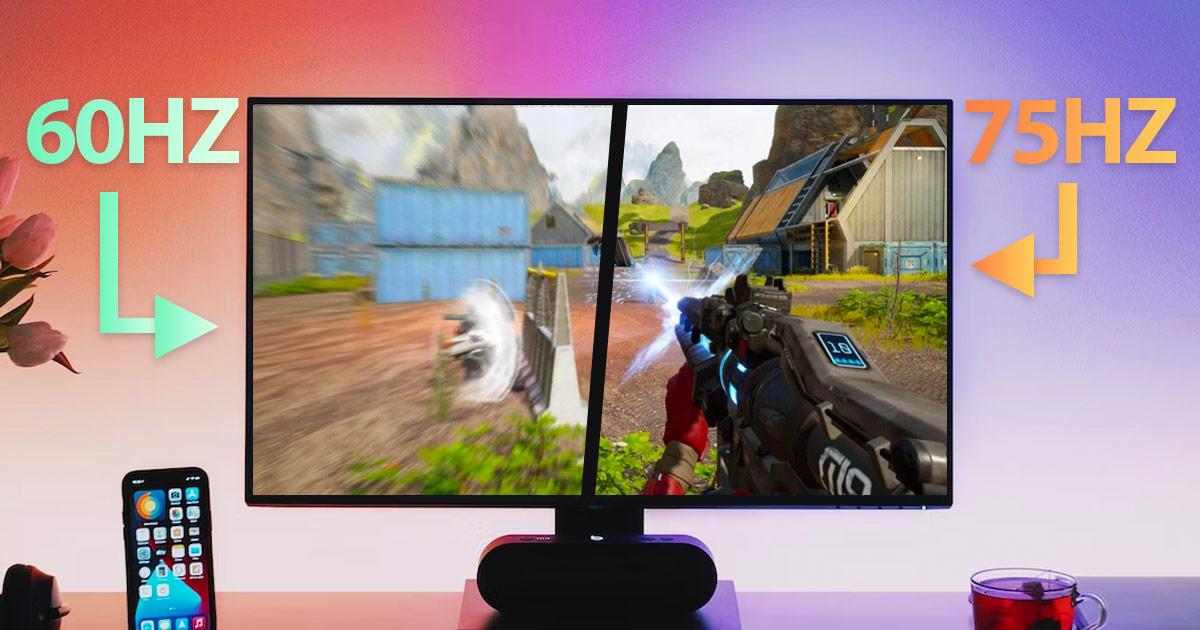60Hz vs. 75Hz Refresh Rates – The Truth About Display Performance

Which refresh rate is the best choice for your monitor? Let’s figure out by having this 60Hz vs 75Hz comparison guide.
When choosing the ideal monitor for your needs, one crucial aspect that often sparks a debate among users is the refresh rate. Two popular options are the 60Hz and 75Hz refresh rates. This comprehensive guide will delve into the key differences between these refresh rates, their impact on display performance, and whether opting for a higher refresh rate is truly advantageous.
Understanding Refresh Rates – 60Hz vs. 75Hz
Before comparing the two refresh rates, it’s essential to grasp what they represent and how they influence the viewing experience. The refresh rate of a monitor is the frequency, in hertz (Hz), at which the display updates the image displayed on the screen. A refresh rate of 60 Hz indicates that the screen is updated 60 times per second, whereas a rate of 75 Hz indicates that it is updated 75 times per second.
The 60Hz Refresh Rate – Is it Good Enough?
For years, a 60Hz refresh rate has been the standard choice for most monitors and is commonly found in budget-friendly options. This refresh rate offers a smooth experience for regular web browsing, document editing, and video-watching tasks. A 60Hz refresh rate might not present noticeable drawbacks for the average user and casual gamer.
Pros of 60Hz Refresh Rate
Cost-effective: 60Hz monitors are generally more affordable than those with higher refresh rates.
Suitable for daily tasks: It provides a smooth experience for everyday computer and multimedia consumption.
Wide compatibility: Almost all devices and applications are optimized for 60Hz displays.
Cons of 60Hz Refresh Rate
Motion blur: Motion blur may be more noticeable in fast-paced games or while scrolling quickly due to the lower refresh rate.
Reduced smoothness: Fast-moving images may not appear as smooth as higher refresh rates.
The 75Hz Refresh Rate – Is it Good and Better than 60Hz?
Now that we know the pros and cons of a 60Hz refresh rate, is a 75Hz refresh rate good? Technological advancements have made monitors with higher refresh rates, such as 75Hz, more popular and accessible. At 75 refreshes per second, the image on a 75Hz screen is updated more smoothly than on a 60Hz screen.
Pros of 75Hz Refresh Rate
Enhanced motion clarity: The additional refresh cycles reduce motion blur and smoother visuals.
Improved gaming experience: Gamers often prefer 75Hz displays as they can make fast-paced games feel more responsive.
Still budget-friendly: 75Hz monitors have become more competitively priced and offer excellent value.
Cons of 75Hz Refresh Rate
Limited compatibility: While most modern devices support 75Hz, some older devices might not be optimized.
Slightly higher price: There might be a slight price increase when opting for a 75Hz display over a 60Hz.
Is 75Hz Refresh Rate Good for You?
Whether a 75Hz refresh rate is good depends on your needs and usage. A 75Hz refresh rate for regular users can significantly improve over 60Hz, particularly in motion clarity and overall smoothness. If you watch videos, play casual games, or work with graphics, a 75Hz display could be a worthy upgrade without stretching your budget.
Is a Higher Refresh Rate Better?
Whether a higher refresh rate is better overall is subjective and depends on your requirements. For serious gamers and professionals working with motion-heavy content like video editing or 3D animation, higher refresh rates, such as 120Hz or 144Hz, might be preferable. These higher refresh rates offer an even more immersive and responsive experience, reducing motion blur to an almost imperceptible level.
Factors to Consider Before Choosing a Refresh Rate
Before making a decision, several factors need to be taken into account:
- Purpose: Determine your primary use for the monitor. If you’re a casual user, 75Hz could be more than enough. However, higher refresh rates might be worth the investment if you’re a gamer or working with demanding graphics.
- Hardware and GPU: Ensure your computer’s hardware and graphics processing unit (GPU) can support the desired refresh rate. Some older GPUs might struggle with higher refresh rates, affecting performance.
- Cost: Consider your budget and whether the price difference between 75hz vs 60hz justifies the benefits you seek.
- Screen Size and Resolution: Larger screens with higher resolutions may benefit more from higher refresh rates, as the increased screen real estate demands more updates.
- Adaptive Sync: Verify the monitor’s compatibility with anti-tearing and anti-stuttering technologies like AMD FreeSync and NVIDIA G-Sync for a better viewing experience.
60hz Vs 75hz – Discover the Best Refresh Rate For You!
In conclusion, the debate between 60Hz vs 75Hz refresh rates centers on personal preference and usage. For most users, a 75Hz refresh rate can provide a noticeable upgrade over the standard 60Hz, offering improved motion clarity and smoother visuals without a significant price increase.
However, higher refresh rates might be the way to go for the most immersive and responsive experience if you are a hardcore gamer or a professional content creator. Remember to consider your needs, hardware compatibility, and budget before deciding. Both 60Hz and 75Hz monitors have their merits, and the key is to find the perfect balance between performance and affordability to suit your requirements.

